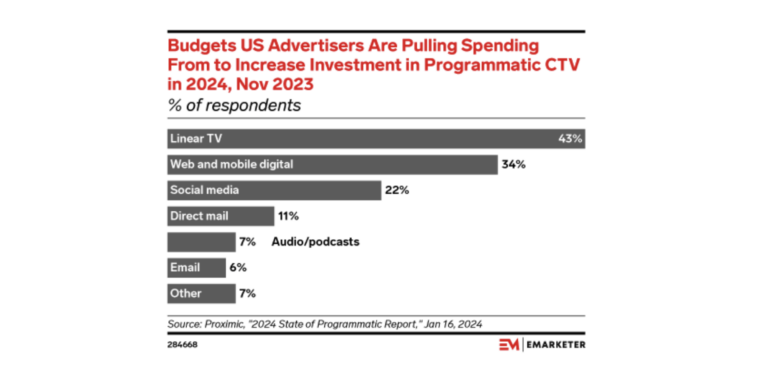As the landscape of advertising continues to evolve, US advertisers are making strategic shifts in their spending to capitalize on emerging technologies and changing consumer behaviors. One significant trend is the movement of advertising budgets from traditional linear TV to programmatic connected TV (CTV). This shift is not just a minor adjustment; it represents a fundamental change in how advertisers are approaching their audiences in an increasingly digital world.
Recent data from Proximic reveals that a substantial 43% of US advertisers are reallocating their budgets away from linear TV to enhance their investments in programmatic CTV. This trend is part of a broader forecasted decline in linear TV ad spending, which is expected to drop by 13.3% in 2024. The decline is somewhat mitigated by temporary increases in ad spend driven by the election year and the Olympics, but the overall trajectory indicates a significant shift away from traditional TV advertising.
Linear TV, once the cornerstone of advertising strategies, is losing its grip due to various factors. The proliferation of streaming services, the rise of on-demand viewing, and the fragmentation of audiences are making it increasingly difficult for advertisers to reach their target demographics through conventional TV channels. Consequently, advertisers are looking towards more dynamic and data-driven solutions to engage consumers effectively.
In contrast to the decline in linear TV, CTV ad spending is on the rise, with a projected increase of 13.3% in 2024. This growth underscores the attractiveness of CTV as a platform that combines the reach of traditional TV with the precision of digital advertising. Programmatic CTV, in particular, is becoming the preferred method for advertisers. By 2025, it is anticipated that programmatic advertising will constitute a staggering 84.2% of the $32.09 billion allocated to US CTV video ad spending, according to eMarketer forecasts.
Programmatic advertising leverages automated technology to buy and place ads, allowing for real-time bidding and targeting. This approach not only enhances efficiency but also enables advertisers to deliver personalized content to viewers, thereby increasing engagement and conversion rates. The ability to utilize data for targeting ensures that ads are shown to the right audience at the right time, maximizing the return on investment.
The growing importance of CTV is further highlighted by a March 2024 study conducted by the Interactive Advertising Bureau (IAB) in collaboration with Advertiser Perceptions and Guideline. The study found that 69% of advertisers consider CTV a “must-buy” component of their advertising strategy. This sentiment reflects the increasing recognition of CTV’s potential to deliver impactful and measurable results.
Advertisers are drawn to CTV for several reasons. Firstly, it offers extensive reach, comparable to that of traditional TV, but with the added advantage of targeting capabilities inherent in digital platforms. Secondly, CTV provides detailed analytics and insights, allowing advertisers to track performance and optimize their campaigns in real time. Lastly, the interactive nature of CTV ads enables brands to engage with consumers in more meaningful and interactive ways, enhancing the overall viewing experience.






Comments
Loading…